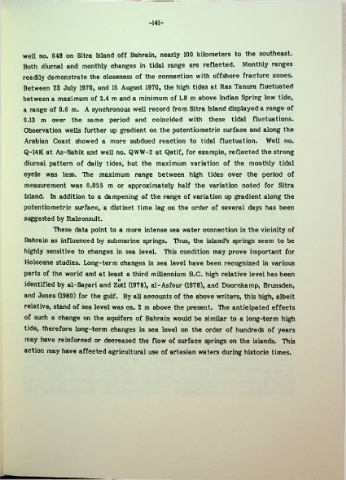Page 165 - Life & Land Use on the Bahrain Islands (Curtis E Larsen)
P. 165
-141-
well no. 648 on Sitra Island off Bahrain, nearly 100 kilometers to the southeast.
Both diurnal and monthly changes in tidal range are reflected. Monthly ranges
readily demonstrate the closeness of the connection with offshore fracture zones.
Between 23 July 1970, and 15 August 1970, the high tides at Ras Tanura fluctuated
between a maximum of 2.4 m and a minimum of 1.8 m above Indian Spring low tide,
a range of 0.6 m. A synchronous well record from Sitra Island displayed a range of
0.13 m over the same period and coincided with these tidal fluctuations.
Observation wells further up gradient on the potentiometric surface and along the
Arabian Coast showed a more subdued reaction to tidal fluctuation. Well no.
Q-14K at As-Sahik and well no. QWW-2 at Qatif, for example, reflected the strong
diurnal pattern of daily tides, but the maximum variation of the monthly tidal
cycle was less. The maximum range between high tides over the period of
measurement was 0.055 m or approximately half the variation noted for Sitra
Island. In addition to a dampening of the range of variation up gradient along the
potentiometric surface, a distinct time lag on the order of several days has been
suggested by Italconsult.
These data point to a more intense sea water connection in the vicinity of
Bahrain as influenced by submarine springs. Thus, the island’s springs seem to be
highly sensitive to changes in sea level. This condition may prove important for
Holocene studies. Long-term changes in sea level have been recognized in various
parts of the world and at least a third millennium B.C. high relative level has been
identified by al-Sayari and Zotl (1978), al-Asfour (1978), and Doornkamp, Brunsden,
and Jones (1980) for the gulf. By all accounts of the above writers, this high, albeit
relative, stand of sea level was ca. 2 m above the present. The anticipated effects
of such a change on the aquifers of Bahrain would be similar to a long-term high
tide, therefore long-term changes in sea level on the order of hundreds of years
may have reinforced or decreased the flow of surface springs on the islands. This
action may have affected agricultural use of artesian waters during historic times.

